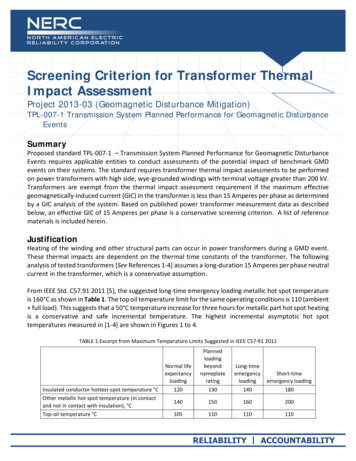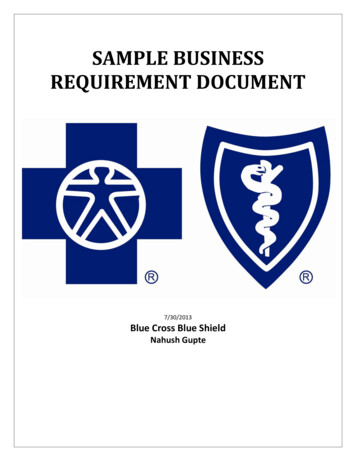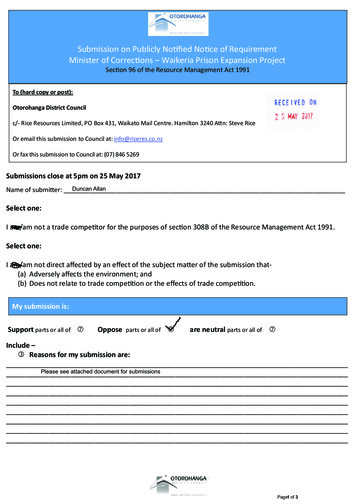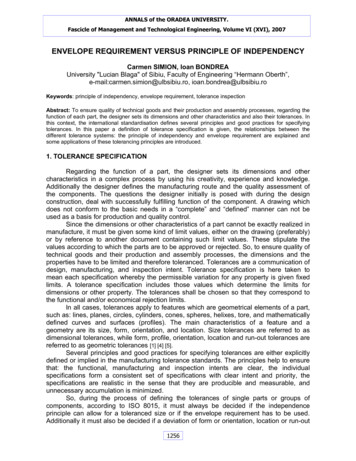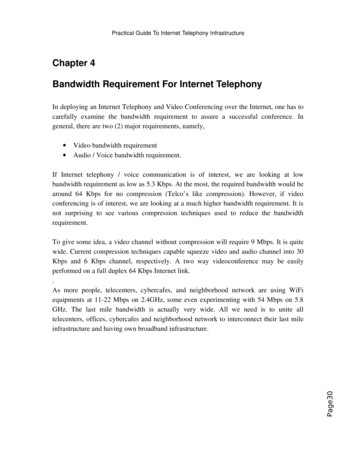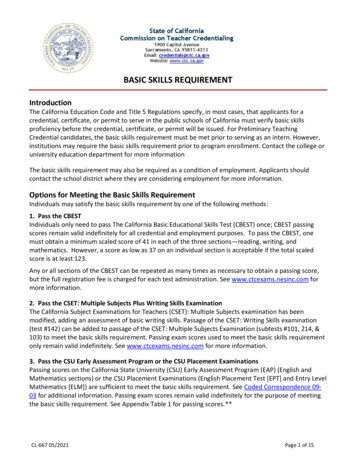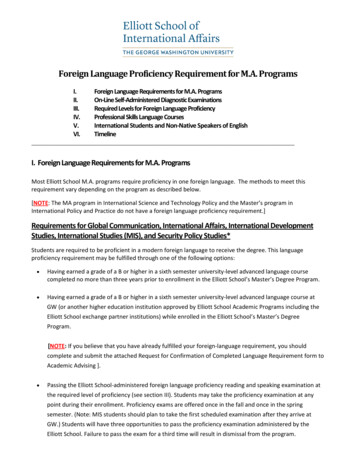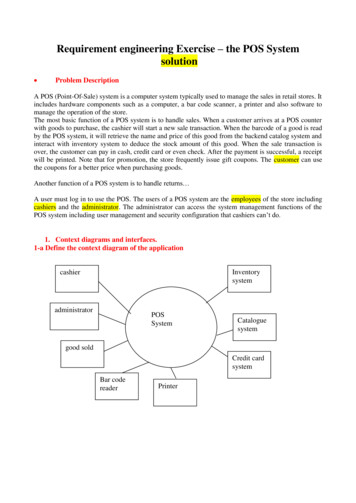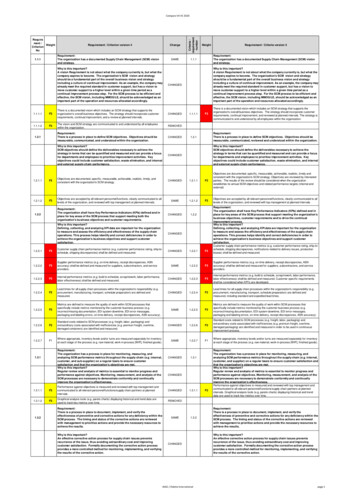
Transcription
Requirement /WeightCriterionNoRequirement / Criterion version 4Requirement:The organization has a documented Supply Chain Management (SCM) visionand strategy.1.1.1ChangeCriteria /requirementnumberCompare V4 V5 2020SAME1.1.1Why is this important?A vision Requirement is not about what the company currently is, but what thecompany aspires to become. The organization's SCM vision and strategyshould be a fundamental part of the overall business vision and strategyincluding a culture of continual improvement. As an example, the company mayalready meet the required standard in customer support, but has a vision tomove customer support to a higher level within a given time period as acontinual improvement process step. For the SCM process to be efficient andeffective, the SCM vision, including MMOG/LE, should be acknowledged as animportant part of the operation and resources allocated accordingly.CHANGED1.1.1.1F2There is a documented vision which includes an SCM strategy that supports theorganization's overall business objectives. The strategy should incorporate customerrequirements, continual improvement, and a review at planned intervals.CHANGED1.1.1.2F2The vision and SCM strategy are communicated to and understood by all employeeswithin the organization.REMOVEDRequirement:There is a process in place to define SCM objectives. Objectives should bemeasurable, communicated, and understood within the organization.CHANGED1.2.1WeightRequirement / Criteria version 5Requirement:The organization has a documented Supply Chain Management (SCM) visionand strategy.Why is this important?A vision Requirement is not about what the company currently is, but what thecompany aspires to become. The organization's SCM vision and strategyshould be a fundamental part of the overall business vision and strategyincluding a culture of continual improvement. As an example, the company mayalready meet the required standard in customer support, but has a vision tomove customer support to a higher level within a given time period as acontinual improvement process step. For the SCM process to be efficient andeffective, the SCM vision, including MMOG/LE, should be acknowledged as animportant part of the operation and resources allocated accordingly.1.1.1.1F3There is a documented vision which includes an SCM strategy that supports theorganization's overall business objectives. The strategy should incorporate customerrequirements, continual improvement, and reviewed at planned intervals. The strategy iscommunicated to and understood by all employees within the organization.Requirement:There is a process in place to define SCM objectives. Objectives should bemeasurable, communicated, reviewed and understood within the organization.1.2.1Why is this important?SCM objectives should define the deliverables necessary to achieve thestrategy in terms that can be quantified and measured and can provide a focusfor departments and employees to prioritize improvement activities. Keyobjectives could include customer satisfaction, waste elimination, and internaland external supply chain performance.Why is this important?SCM objectives should define the deliverables necessary to achieve thestrategy in terms that can be quantified and measured and can provide a focusfor departments and employees to prioritize improvement activities. Keyobjectives could include customer satisfaction, waste elimination, and internaland external supply chain performance.CHANGEDCHANGED1.2.1.1F2Objectives are documented, specific, measurable, achievable, realistic, timely andconsistent with the organization's SCM strategy. Objectives are reviewed by interestedparties. The results of the review should be considered when the organizationestablishes its annual SCM objectives and related performance targets (internal andexternal)F2Objectives are accepted by all relevant personnel/functions, clearly communicated to alllevels of the organization, and reviewed with top management at planned intervals.1.2.1.1F2Objectives are documented, specific, measurable, achievable, realistic, timely, andconsistent with the organization's SCM strategy.1.2.1.2F2Objectives are accepted by all relevant personnel/functions, clearly communicated to alllevels of the organization, and reviewed with top management at planned intervals.SAME1.2.1.2Requirement:The organization shall have Key Performance Indicators (KPIs) defined and inplace for key areas of the SCM process that support meeting both theorganization's business objectives and customer requirements.CHANGED1.2.2Why is this important?Defining, collecting, and analyzing KPI data are important for the organizationto measure and assess the efficiency and effectiveness of the supply chainoperations. This process helps identify and correct deficiencies in order toachieve the organization's business objectives and support 2.2.2F3Supplier performance metrics (e.g. on-time delivery, receipt discrepancies, ASNaccuracy) shall be defined and measured for suppliers, subcontractors, and serviceproviders.1.2.2Requirement:The organization shall have Key Performance Indicators (KPIs) defined and inplace for key areas of the SCM process that support meeting the organization'sbusiness objectives, customer requirements and to drive the continualimprovement process.Why is this important?Defining, collecting, and analyzing KPI data are important for the organizationto measure and assess the efficiency and effectiveness of the supply chainoperations. This process helps identify and correct deficiencies in order toachieve the organization's business objectives and support customersatisfaction.Customer supply chain performance metrics (e.g. customer performance rating, ship-toschedule, shipping discrepancies, notifications related to delivery issues, productionlosses) shall be defined and measured.1.2.2.1F3Customer supply chain performance metrics (e.g. customer performance rating, ship-toschedule, shipping discrepancies) shall be defined and measured.1.2.2.2F3Supplier performance metrics (e.g. on-time delivery, receipt discrepancies, ASNaccuracy) shall be defined and measured for suppliers, subcontractors, and serviceproviders.1.2.2.3F3Internal performance metrics (e.g. build to schedule, scrap/rework, labor performance,labor effectiveness) shall be defined and measured.CHANGED1.2.2.3F3Internal performance metrics (e.g. build to schedule, scrap/rework, labor performance,labor effectiveness) shall be defined and measured. Customer specific requirementsshall be considered when KPI's are developed.1.2.2.4F2Lead times for all supply chain processes within the organization's responsibility (e.g.procurement, manufacturing, transport, schedule preparation) are defined andmeasured.CHANGED1.2.2.4F2Lead times for all supply chain processes within the organization's responsibility (e.g.procurement, manufacturing, transport, schedule preparation) are defined andmeasured, including standard and expedited lead times.1.2.2.5F2Metrics are defined to measure the quality of work within SCM processes thatspecifically include metrics monitored by the customer business process (e.g.incorrect/missing documentation, EDI system downtime, EDI error messages,packaging and labeling errors, on-time delivery, receipt discrepancies, ASN accuracy).SAME1.2.2.5F2Metrics are defined to measure the quality of work within SCM processes thatspecifically include metrics monitored by the customer business process (e.g.incorrect/missing documentation, EDI system downtime, EDI error messages,packaging and labeling errors, on-time delivery, receipt discrepancies, ASN accuracy).1.2.2.6F2Standard costs related to SCM processes (e.g. freight, labor, packaging) andextraordinary costs associated with inefficiencies (e.g. premium freight, overtime,damaged containers) are identified and measured.CHANGED1.2.2.6F2Standard costs related to SCM processes (e.g. freight, labor, packaging) andextraordinary costs associated with inefficiencies (e.g. premium freight, overtime,damaged packaging) are identified and measured in order to be used in continuousimprovement process.1.2.2.7F1Where appropriate, inventory levels and/or turns are measured separately for inventoryat each stage of the process (e.g. raw material, work-in-process [WIP], finished goods).SAME1.2.2.7F1Where appropriate, inventory levels and/or turns are measured separately for inventoryat each stage of the process (e.g. raw material, work-in-process [WIP], finished goods).CHANGED1.3.1Requirement:The organization has a process in place for monitoring, measuring, andanalyzing SCM performance metrics throughout the supply chain (e.g. internal,customer, and sub-supplier) on a regular basis to ensure customersatisfaction and that the organization's objectives are met.Why is this important?Regular review and analysis of metrics is essential to monitor progress andperformance against objectives. Monitoring, measurement, and analysis of theSCM processes are necessary to demonstrate conformity and continuallyimprove the organization's effectiveness.1.3.1CHANGED1.3.1.1F2Performance against objectives is measured and reviewed with top management andcommunicated to all relevant personnel/functions/supply chain partners at plannedintervals.CHANGED1.3.1.2F2Graphical analysis tools (e.g. pareto charts) displaying historical and trend data areused to track key metrics over time.REMOVED1.3.2Requirement:There is a process in place to document, implement, and verify theeffectiveness of preventive and corrective actions for any deficiency within theSCM process. The timing and status of the corrective actions are reviewedwith management to prioritize actions and provide the necessary resources toachieve the results.Why is this important?An effective corrective action process for supply chain issues preventsrecurrence of the issue, thus avoiding extraordinary cost and improvingcustomer satisfaction. Formally documenting the corrective action processprovides a more controlled method for monitoring, implementing, and verifyingthe results of the corrective action.SAME1.3.1.11.3.2CHANGEDAIAG / Odette InternationalF2Requirement:The organization has a process in place for monitoring, measuring, andanalyzing SCM performance metrics throughout the supply chain (e.g. internal,customer, and supplier) on a regular basis to ensure customer satisfaction andthat the organization's objectives are met.Why is this important?Regular review and analysis of metrics is essential to monitor progress andperformance against objectives. Monitoring, measurement, and analysis of theSCM processes are necessary to demonstrate conformity and continuallyimprove the organization's effectiveness.Performance against objectives is measured and reviewed with top management andcommunicated to all relevant personnel/functions/supply chain partners at plannedintervals. Graphical analysis tools (e.g. pareto charts) displaying historical and trenddata are used to track key metrics over time.Requirement:There is a process in place to document, implement, and verify theeffectiveness of preventive and corrective actions for any deficiency within theSCM process. The timing and status of the corrective actions are reviewedwith management to prioritize actions and provide the necessary resources toachieve the results.Why is this important?An effective corrective action process for supply chain issues preventsrecurrence of the issue, thus avoiding extraordinary cost and improvingcustomer satisfaction. Formally documenting the corrective action processprovides a more controlled method for monitoring, implementing, and verifyingthe results of the corrective action.page 1
Compare V4 V5 20201.3.2.1F2There are procedures and/or work instructions in place that define a structured problemsolving process that prevents recurrence of supply chain issues (e.g. late/inaccurateASNs, late/missed shipments, BOM errors). The process includes: timely identification,response, containment, and corrective actions. Management prioritizes corrective andpreventive actions and provides the resources needed to resolve each deficiency.CHANGED1.3.2.1F3The organization shall have a documented process(es) for problem solving including:a) defined approaches for various types and scale of problems (e.g. late/inaccurateASNs, late/missed shipments, BOM errors).b) containment, interim actions, and related activities necessary for control ofnonconforming outputsc) root cause analysis, methodology used, analysis, and results;d) implementation of systemic corrective actions, including consideration of the impacton similar processese) verification of the effectiveness of implemented corrective actions;f) reviewing and, where necessary, updating the appropriate documented information(e.g. update work instructions, train personnel, poka-yoke)g) lessons learned should be applied to other relevant processesWhere the customer has specific prescribed processes, tools, or systems for problemsolving, the organization shall use those processes, tools, or systems unless otherwiseapproved by the customer.1.3.2.2F21.3.2.3F21.4.1The corrective action plan includes a description of the problem, containment, rootcause analysis, preventive actions, timing, assigned responsibilities, and any additionalrequired resources.Corrective and preventive actions are validated at the conclusion of each incident todetermine whether the planned results have been achieved and to assess the need forany further actions (e.g. update work instructions, train personnel, poka-yoke). Anylessons learned should be applied to other relevant processes.Requirement:There is a process in place that engages management, employees, andbusiness partners in continually improving the efficiency and effectiveness ofthe SCM processes throughout the entire organization and with all supplychain partners.Why is this important?The deployment of improvement activities throughout the supply chain isnecessary in order to increase efficiency, reduce waste and cost, and improveoverall customer satisfaction. The objective is to develop a continualimprovement culture in all supply chain partners so that the resultingprocesses are lean, stable, and sustainable.REMOVEDREMOVEDSAME1.4.1SAME1.4.1.1F1A documented continual improvement process is in place and used throughout the entireorganization with all supply chain partners.CHANGED1.4.1.1F21.4.1.2F1The continual improvement process encourages employees and all supply chainpartners to submit proposals for continual improvement.CHANGED1.4.1.2F11.4.1.3F1Employees at all levels of the organization are allotted time to actively participate incontinual improvement .1.1.1F12.1.1.2F1Requirement:There is a process in place to identify and analyze constraints that limit theorganization's ability to optimize throughput. Actions are taken to reduce,minimize, or eliminate constraints.Why is this important?For organizations to remain competitive and reduce cost, specific areas ofimprovement need to be identified throughout the supply chain. Listed in thecriteria below there are fundamental processes that should be evaluated by theSCM function as a minimum requirement. There may be additional constraintsidentified through the organization's internal assessment process and/orcontinual improvement metrics.There shall be a process in place to identify and, where appropriate, manage bottleneckprocesses throughout the supply chain (e.g. capacity production, labor, supplierconstraints) to maximize output while ensuring that production and delivery to thecustomer are not compromised.Production batch/lot size is evaluated on a regular basis and is adjusted accordingly insupport of lean objectives.Set-up/change-over time is evaluated on a regular basis and is adjusted accordingly insupport of lean objectives.Throughput time is evaluated on a regular basis and is improved where possible.An effective cycle counting program is in place to identify root causes of inventoryvariation and implement corrective actions to prevent recurrence of the cause ofvariation.Requirement:There is a process in place to continually develop the relationship between allpartners in the supply .4.2.3F1CHANGED1.4.2.4F1CHANGED1.5.1SAMEThe organization has a process in place for the continual development of relationshipswith all supply chain partners.CHANGEDRequirement:The organizational structure recognizes the importance within the business ofsupply chain management, SCM interfaces, and information and physicalflows.Why is this important?It is vital to gain a clear understanding of the organizational structure andprocesses in order to provide a solid foundation for achieving customersatisfaction, internal strategies and objectives, and continual improvement.The organizational structure is documented and regularly reviewed to ensure there issufficient focus and resource for all SCM processes.Documentation exists (e.g. flow charts) describing the information flow of all SCMprocesses, including interfaces with customers, other internal functions, suppliers,subcontractors, and service providers.The organization leverages an advanced technology supply chain project (e.g., IoT,machine learning, data lakes, augmented reality, blockchain) to improve outcomes suchas shop floor digitization, improving supplier performance, delivering comprehensivetraceability, reducing skills gap, safeguarding manufacturing, etc.Requirement:There is a process in place to identify and analyze constraints that limit theorganization's ability to optimize throughput. Actions are taken to reduce,minimize, or eliminate constraints.Why is this important?For organizations to remain competitive and reduce cost, specific areas ofimprovement need to be identified throughout the supply chain. Listed in thecriteria below there are fundamental processes that should be evaluated by theSCM function as a minimum requirement. There may be additional constraintsidentified through the organization's internal assessment process and/orcontinual improvement metrics.There shall be a process in place to identify and, where appropriate, manageconstraining processes throughout the supply chain (e.g. production capacity, materialflow analysis, labor, supplier) to maximize output while ensuring that production anddelivery to the customer are not compromised.Production batch/lot size and throughput times are evaluated on a regular basis and areadjusted accordingly in support of lean objectives.Set-up/change-over time is evaluated on a regular basis and is adjusted accordingly insupport of lean objectives.REMOVEDWhy is this important?Successful supply chain relationships begin with mutual trust and respect.The development process should consider customer expectations as well asaspects of corporate responsibility such as social, environmental, economic,and legal requirements. Developing relationships relies on organizationsworking together for mutual benefit and reward for the medium and long term.The process provides a strong basis for responding to market conditions andincreasing competitiveness by continually examining the use and introductionof new business techniques, processes, and technology.Documented action plans are in place to implement the continual development ofrelationships with all supply chain partners.A formal method of analysis (e.g. Strengths Weaknesses Opportunities Threats[SWOT] analysis, Benchmarking) is used to assess all supply chain partners.Requirement:There is a process in place to continually develop working relationships withother functions within the organization to ensure that overall businessobjectives are satisfied.Why is this important?Understanding, communicating, and satisfying the requirements of otherfunctions are
continual improvement process step. For the SCM process to be efficient and effective, the SCM vision, including MMOG/LE, should be acknowledged as an important part of the operation and resources allocated accordingly. 1.1.1.1 F2 There is a documented vision which includes an SCM strat

